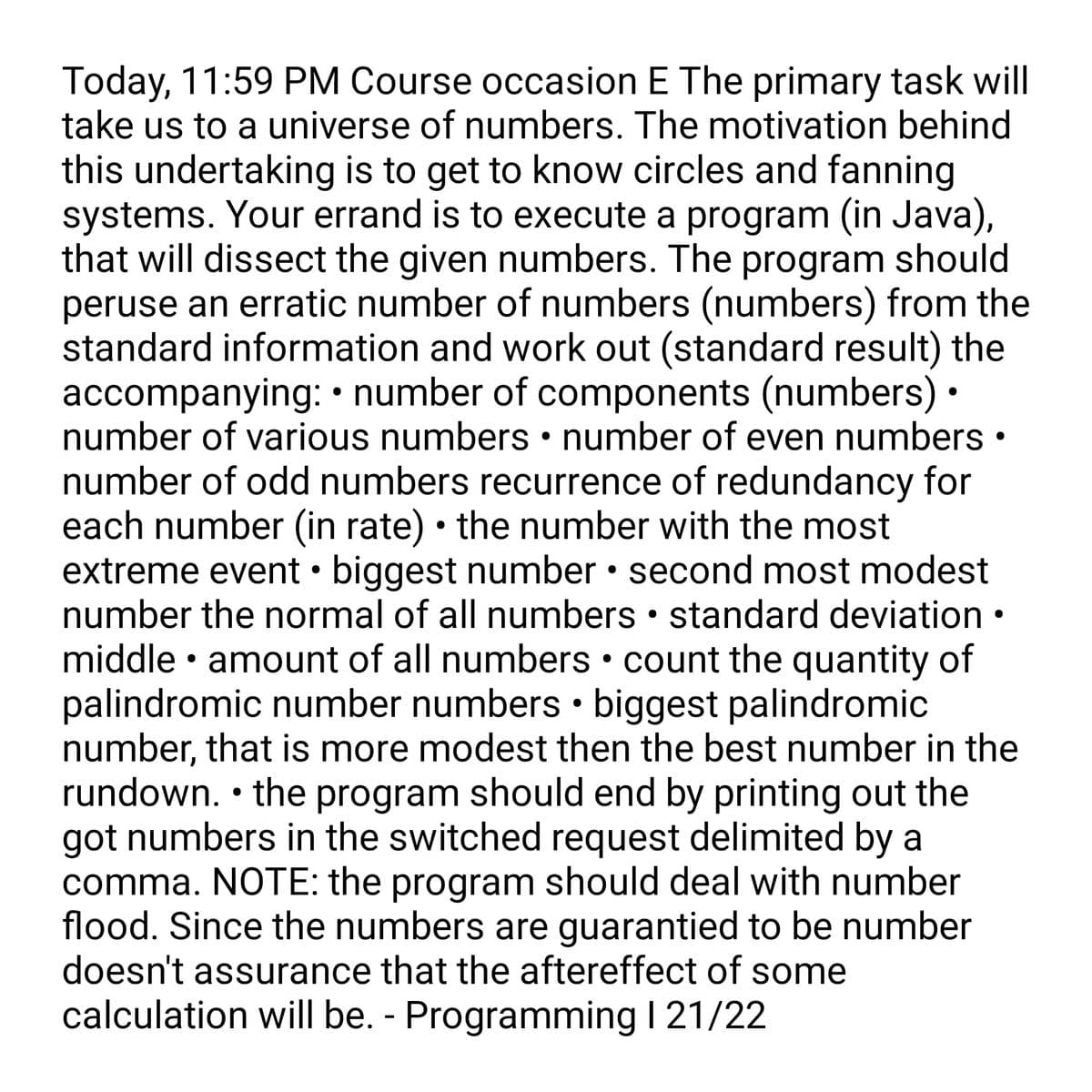uestion 13.
Computer Networking: A Top-Down Approach (7th Edition)
7th Edition
ISBN:9780133594140
Author:James Kurose, Keith Ross
Publisher:James Kurose, Keith Ross
Chapter1: Computer Networks And The Internet
Section: Chapter Questions
Problem R1RQ: What is the difference between a host and an end system? List several different types of end...
Related questions
Question
Question 13. The before code.

Transcribed Image Text:●
●
Today, 11:59 PM Course occasion E The primary task will
take us to a universe of numbers. The motivation behind
this undertaking is to get to know circles and fanning
systems. Your errand is to execute a program (in Java),
that will dissect the given numbers. The program should
peruse an erratic number of numbers (numbers) from the
standard information and work out (standard result) the
accompanying: • number of components (numbers).
number of various numbers • number of even numbers •
number of odd numbers recurrence of redundancy for
each number (in rate) • the number with the most
extreme event • biggest number second most modest
number the normal of all numbers standard deviation
middle • amount of all numbers count the quantity of
palindromic number numbers biggest palindromic
number, that is more modest then the best number in the
rundown. • the program should end by printing out the
got numbers in the switched request delimited by a
comma. NOTE: the program should deal with number
flood. Since the numbers are guarantied to be number
doesn't assurance that the aftereffect of some
calculation will be. - Programming | 21/22
●
●
●
●
Expert Solution
This question has been solved!
Explore an expertly crafted, step-by-step solution for a thorough understanding of key concepts.
Step by step
Solved in 3 steps with 4 images

Recommended textbooks for you

Computer Networking: A Top-Down Approach (7th Edi…
Computer Engineering
ISBN:
9780133594140
Author:
James Kurose, Keith Ross
Publisher:
PEARSON

Computer Organization and Design MIPS Edition, Fi…
Computer Engineering
ISBN:
9780124077263
Author:
David A. Patterson, John L. Hennessy
Publisher:
Elsevier Science

Network+ Guide to Networks (MindTap Course List)
Computer Engineering
ISBN:
9781337569330
Author:
Jill West, Tamara Dean, Jean Andrews
Publisher:
Cengage Learning

Computer Networking: A Top-Down Approach (7th Edi…
Computer Engineering
ISBN:
9780133594140
Author:
James Kurose, Keith Ross
Publisher:
PEARSON

Computer Organization and Design MIPS Edition, Fi…
Computer Engineering
ISBN:
9780124077263
Author:
David A. Patterson, John L. Hennessy
Publisher:
Elsevier Science

Network+ Guide to Networks (MindTap Course List)
Computer Engineering
ISBN:
9781337569330
Author:
Jill West, Tamara Dean, Jean Andrews
Publisher:
Cengage Learning

Concepts of Database Management
Computer Engineering
ISBN:
9781337093422
Author:
Joy L. Starks, Philip J. Pratt, Mary Z. Last
Publisher:
Cengage Learning

Prelude to Programming
Computer Engineering
ISBN:
9780133750423
Author:
VENIT, Stewart
Publisher:
Pearson Education

Sc Business Data Communications and Networking, T…
Computer Engineering
ISBN:
9781119368830
Author:
FITZGERALD
Publisher:
WILEY